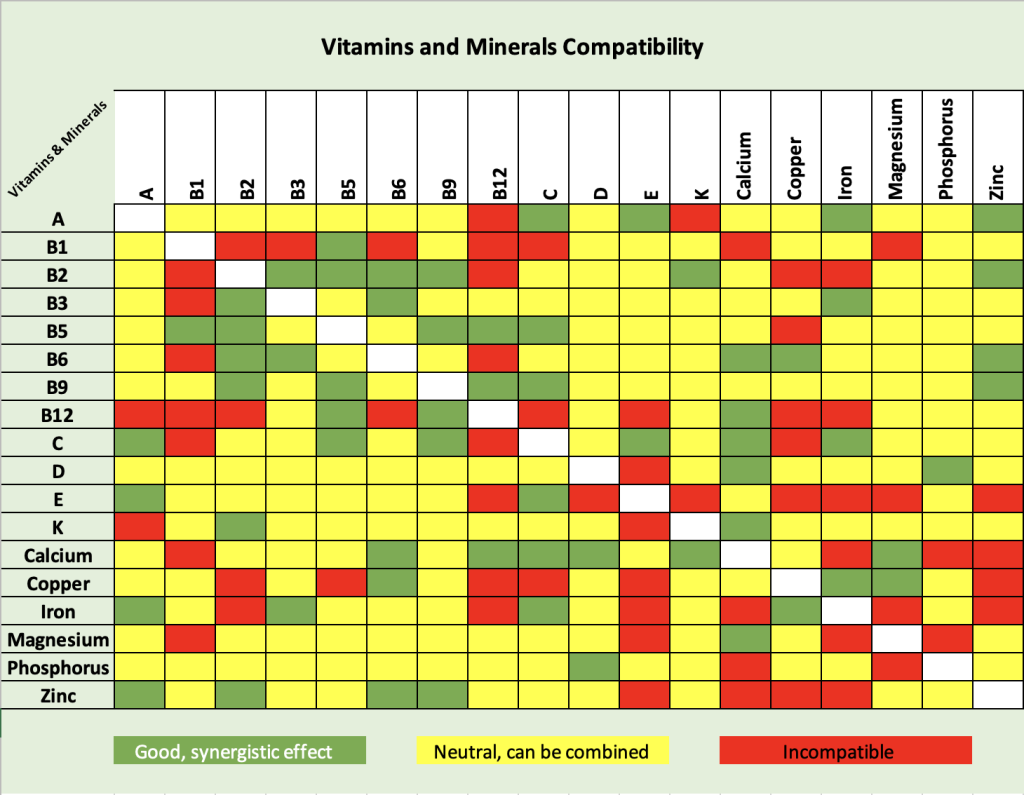If you’ve decided to incorporate vitamins into your regimen, you have the option of choosing either a multivitamin complex or individual vitamins and minerals. While it might be convenient to take a single pill that provides all the necessary nutrients, it’s important to ask whether this is beneficial for you. Taking minerals and vitamins separately allows for compatibility and prevents overdosing, especially with nutrients that you are already getting enough of from your diet.
Our body is like a chemical laboratory, with a multitude of processes occurring simultaneously, involving various elements obtained externally, such as proteins, fats, carbohydrates, vitamins, and minerals.
For our bodies to effectively assimilate and utilize these substances, it’s crucial to know which combinations work well together and which do not. It has been established that certain substances can suppress the effects of others (antagonism), while some aid each other, mutually enhancing their impact (synergism). Furthermore, some vitamins and minerals cannot be absorbed or utilized by the body in isolation.
Let’s consider how well, or poorly, the most common vitamins (A, B1, B2, B3, B5, B6, B9, B12, C, D, E, K) and minerals (calcium, copper, iron, magnesium, phosphorus, zinc) pair with each other, which can be guided by a chart to follow.

Here is the link to download, save, and print the ‘Vitamins and Minerals Compatibility’ table referenced above: http://mikesbalance.com/wp-content/uploads/2023/06/Vitamins-and-Minerals-Compatibility.png
Under the definition of “compatibility”, we refer to a good combination of vitamins and minerals that interact well with each other, promoting mutual absorption and/or enhancing their effects. As such, it is advisable to take them together. “Incompatible” refers to non-relevant combinations that should be avoided. The effect of taking antagonistic vitamins and minerals together will be minimal or even negative. They should be taken separately, with a 4-6 hour interval. “Neutral” combinations can be used together or individually.
A good balance between vitamins and minerals
The combined intake of well-matched essential elements results in a significantly greater effect than their individual consumption. In this context, synergy means a higher absorption of nutrients. Vitamins and minerals can interact with each other during food intake or within the stomach, promoting mutual absorption. When this effect is amplified due to their involvement in the same process, it’s referred to as pharmacological interaction.
Let’s examine the most studied options:
Vitamin A: Zinc enhances the absorption of vitamin A, participating in its transformation into the retina. Vitamins A and C, as well as copper, significantly boost the absorption of iron and influence the utilization of iron stores present in the liver.
B vitamins: B2 (riboflavin) increases the absorption rate of zinc, while B6 (pyridoxine) reduces its loss from the body. Vitamin B6 also pairs well with copper, and magnesium enhances its ability to penetrate cells. Vitamin B3 (PP, niacin, nicotinic acid) is well-suited with iron and copper. Calcium aids in the body’s absorption of Vitamin B12 (cobalamin), which is further facilitated by vitamins B6, D, and C. The absorption of all B group vitamins (except B1) is promoted by magnesium.
Vitamin C: It is an excellent catalyst for the absorption of iron, which is beneficial for all types of anemia. This is why iron-rich foods should be consumed with orange, tomato, or grapefruit juice instead of coffee or tea. Meat should be consumed alongside spinach or any other greenery. Copper, which is abundant in peas, beans, and other legumes, aids in the absorption of iron. Furthermore, Vitamin C aids in the absorption of calcium and chromium and improves the uptake of selenium.
Vitamin D (Vitamin D3, cholecalciferol): It is necessary for calcium and phosphorus to enhance their metabolism in the body.
Vitamin E (tocopherol): It pairs well with selenium, which boosts its antioxidant activity. Together, they create a comprehensive “trap” for fat-soluble oxidants.
Vitamin K: It is necessary for calcium in the construction of bone tissue. Calcium, in turn, is compatible with vitamins B6, B12, D. Therefore, a vitamin-mineral complex containing calcium, magnesium, boron, and vitamins B6, B12, D, and K provides the best absorption of calcium and reduces its loss from the body. However, the complex shouldn’t contain excessive magnesium, or the result could be counterproductive.
Poor compatibility between vitamins and minerals
In some combinations, vitamins and minerals act antagonistically, breaking down or suppressing each other’s properties. It is advisable to take such vitamins and minerals separately, with a 4-6 hour interval.
To increase the absorption of Vitamin E, it should be consumed separately from magnesium, zinc, copper, and iron.
Vitamin B12 (cobalamin) has poor compatibility with iron, manganese, and copper, becoming inactive under their influence.
While magnesium and calcium do not hinder the absorption of Vitamin B1, they significantly reduce its solubility in water.
Iron and copper slow the absorption of Vitamin B2. Copper also decreases the activity of Vitamin B5 (pantothenic acid), B12, C, and E.
Vitamin B9 (folic acid) and zinc block each other. Together, they create an insoluble complex, which impairs their absorption.
When a person takes vitamins C, B12, copper, and B1 in separate tablets and at different times, the maximum concentration in the blood can be reached, reducing the potential for negative interactions.
Combining Vitamins with Vitamins
Vitamin A
As an antioxidant, it pairs well with other vitamins with antioxidant abilities – Vitamins E, C, and K.
B Vitamins Group
Many of these vitamins do not combine well with each other. Vitamins B1 and B2 significantly enhance the absorption of Vitamin B5, but the concurrent intake of Vitamin B1 and Vitamin B2 is not advisable as it may amplify allergic reactions.
- Vitamin B3 (Niacin) mutually enhances the absorption of Vitamins B2, B6, and H. The transition of Vitamins B3, B6, B9, and K to an active form involves Vitamin B2. However, Vitamin B3 is not compatible with Vitamin B1.
- Vitamins B2, B3, and B12 completely deplete Vitamin B1 (Thiamine), and Vitamin B6 hinders its transformation into a biologically active form.
- Vitamin B5 (Pantothenic acid) can be consumed along with Vitamins B1, B2, B4, B9, B12, and C, facilitating their absorption.
- Vitamin B6 should not be combined with Vitamins B1 and B12.
- Vitamin B12 (Cobalamin) pairs well with Vitamins B5 and B9 but contributes to the destruction of Vitamin B6. Meanwhile, under the influence of Vitamins A, B1, B2, B6, C, and E, Vitamin B12 becomes inactive.
However, if we’re talking about vitamin complexes where all B-group vitamins are combined, such intake is permissible because the release time for each vitamin is calculated in these complexes.
Vitamin C (Ascorbic Acid)
It is highly compatible with Vitamins A, E, B5, and B9. The antioxidant effect of Vitamin C enhances the absorption of carotenoids, Vitamin E, and flavonoids. It also helps maintain Vitamin B9 in tissues. Vitamin C does not combine well with Vitamins B1 and B12.
Vitamin E (Tocopherol)
Vitamins E and D are antagonists. To enhance the absorption of Vitamin E, it should be taken separately from Vitamin D, as well as Vitamins B12 and K.
Vitamin K
Vitamins K and D are highly synergistic because they both interact with proteins involved in the calcification of bones and tissues. In this case, Vitamin D produces the protein, and Vitamin K carboxylates (activates) it. Studies comparing the use of Vitamin K alone and Vitamin K combined with Vitamin D have shown that combined therapy contributes to improved bone health as evaluated by bone mineral density.
The absorption of Vitamin K with fat-soluble vitamins such as A or E may be less complete than with each of them separately. If a Vitamin K supplement is needed to make up a deficit, it is better to take it with a two-hour interval from others.
Combining Minerals with Minerals
Calcium
The calcium metabolism is aided by magnesium, boron, manganese, and silicon. However, magnesium can influence calcium levels by affecting hormones that control its absorption and exchange.
Calcium is an antagonist of sodium, phosphorus, zinc, and iron. An excess of magnesium, iron, and phosphorus leads to a calcium deficit. Calcium, in turn, hinders the absorption of these minerals.
Magnesium
It poorly combines with phosphorus, iron, and manganese (and also with calcium in large quantities). An elevated amount of magnesium leads to a deficit of calcium and phosphorus. In regulating vascular tone, magnesium and calcium ions act as antagonists: calcium plays a leading role in the contraction of the smooth muscles of the blood vessels, while magnesium, on the contrary, aids their expansion and facilitates the absorption of calcium and phosphorus.
The joint intake of magnesium and calcium can reduce their effectiveness. A high dose of minerals mixed with others reduces their absorptive capacity. Thus, minerals compete in the process of absorption and no one wins. To gain the maximum benefits of each, they should be taken with an interval of at least two hours.
Phosphorus
Phosphorus and calcium are closely related in the body and balance each other out when performing many functions. An excess of phosphorus enhances the extraction of calcium from the bones. As a result, osteoporosis develops, the likelihood of heart attacks increases, and the risk of mortality from cardiovascular diseases rises. Phosphorus stimulates calcification – an irreversible damage to vessels, the deposition of calcium on the inner wall in the form of plaques. Calcium is incompatible with magnesium, and an excess of magnesium and calcium leads to a deficit of phosphorus in the body.
Zinc
Zinc strengthens the immune system. This mineral can be used to prevent a common cold or shorten its duration. However, it should be known that zinc disrupts the absorption of copper. Some people need copper to compensate for the deficit caused by certain diseases. Moreover, the body’s absorption of zinc is hindered by calcium and iron.
Copper
It impedes the absorption of zinc, in large amounts it worsens the absorption of iron, while in small quantities, it has a beneficial effect.
If you need to take copper and zinc simultaneously, make an interval between them of at least two hours. In the long run, high doses of zinc (50 mg or + per day for 10 weeks or +) can cause a copper deficiency.
Potassium
The competition between potassium and calcium in the absorption of these primary minerals can decrease the collective benefits of each. People who are working, exercising, or suffering from digestive issues in a humid climate might have a deficiency in potassium. When taking these two dietary supplements, it’s necessary to take breaks for several hours in between. Sodium enhances the absorption of potassium. If there is a deficiency of potassium and sodium in the diet, lithium levels in the body may increase. Sodium, rubidium, cesium, and thallium can displace potassium from tissues.
Manganese
It has poor compatibility with calcium and iron. Both calcium and iron impair the absorption of manganese.
Iron
It hinders the absorption of calcium and manganese, while zinc, magnesium, chromium, and calcium hinder the absorption of iron. A sufficient amount of copper aids the absorption of iron.

Frequently Asked Questions
The absorption of Vitamin D is reduced by iron supplements and high concentration of Vitamin E. Please note, that taking vitamin D supplements along with calcium supplements can lead to an excess of calcium in the blood.
Biotin can be taken with other vitamins. It is necessary for the metabolism of Vitamin PP, Vitamin B5, folic acid, and Vitamin B12, as well as for the synthesis of ascorbic acid. However, there is one notable interaction: biotin can interfere with certain lab tests, including those for thyroid function, so it’s generally recommended to let your healthcare provider know if you are taking a biotin supplement, especially if you’re getting blood tests.
These essential elements have neutral compatibility. They do not “interfere” with or “assist” each other.
These minerals are incompatible. Magnesium can interfere with the body’s ability to absorb iron, particularly if taken in large doses. To optimize absorption of both minerals, it’s often suggested to take iron and magnesium at different times of the day. For instance, you could take one in the morning and the other in the evening. It’s also important to note that certain foods, like those rich in vitamin C, can enhance iron absorption, while others like dairy products or caffeine can inhibit it.
Yes, you can take zinc and vitamin C at the same time. Both are essential nutrients that the body needs to function properly, and they can be safely consumed together. Zinc and vitamin C can actually complement each other, as vitamin C enhances the absorption of zinc in the body. That said, it’s always a good idea to follow the recommended daily allowances for these nutrients. For adults, the recommended dietary allowance (RDA) is 8 mg/day for women and 11 mg/day for men for zinc, and 75 mg/day for women and 90 mg/day for men for vitamin C.
Yes, vitamin C and vitamin D can be taken together. They work in different ways and there’s no known negative interaction between the two.

Disclaimer
The information provided in this article is for general informational purposes only. The content presented on this website should be considered solely as opinions and personal experiences. Read more
